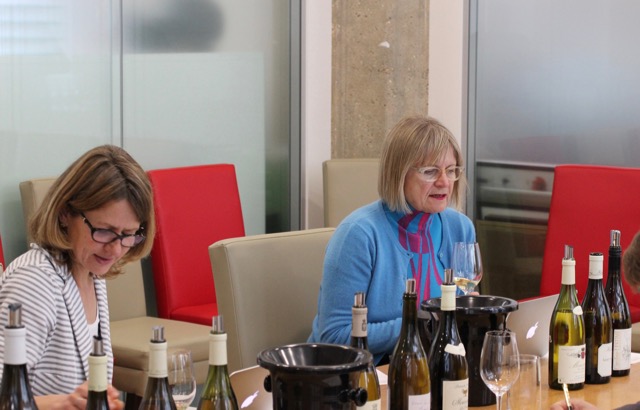2008 White Burgundy: Time to Mature
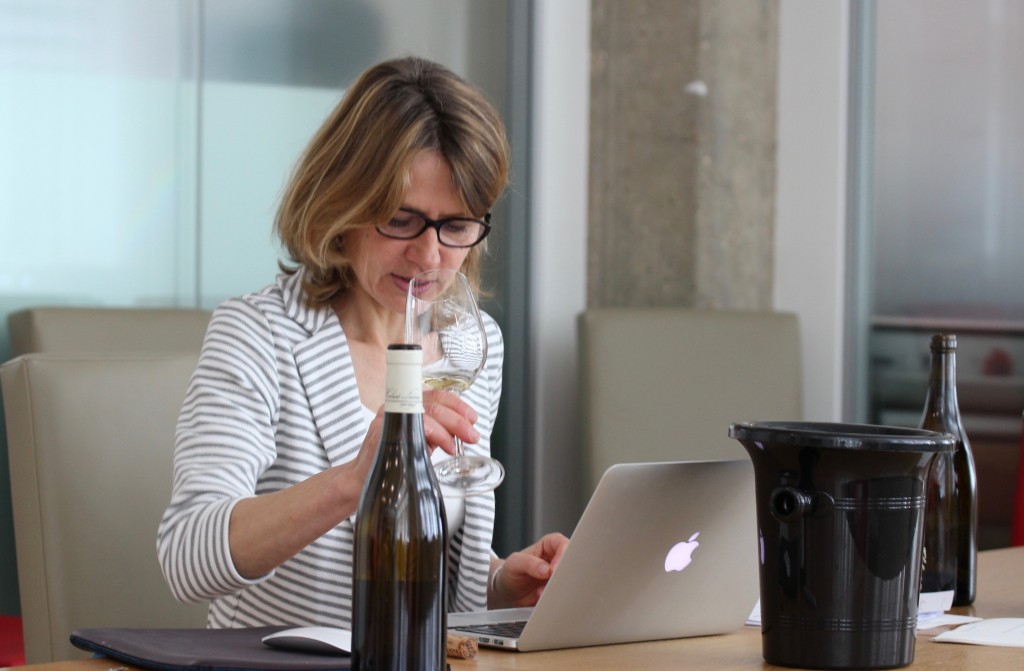
I am particularly interested in the capacity of white Burgundy to mature into a truly delicious and complex wine worthy of the wait. However problems of premature oxidation in the late Nineties, which rumbled on through the Naughties, understandably resulted in a general lack of confidence in ageing white Burgundy.
I collected 23 bottles of the 2008 vintage directly from the growers on my summer visit in 2016 and decided to invite a group of experienced Burgundy tasters – wine writers, Burgundy importers and sommeliers – to taste them with me. These were people in key positions to highlight the advantages of waiting for a gracefully matured white Burgundy, measured against the risks. It was a risk in itself to organise such a tasting, but could be an effective way to challenge pre-conceptions – if the results were favourable – and to begin to change them.
I asked David Roberts MW of Goedhuis & Co. to co-host the tasting in Goedhuis’s new tasting rooms in London’s trendy Bermondsey. Burgundy buyer David Roberts is someone who appreciates mature white Burgundy and was the perfect person to ask.
As to those risks… of the 23 wines only one wine was fully oxidised, which was a relief. Another was corked. Thus serious faults were minimal. The wines were more consistent than I could have hoped – both in quality and style. I felt the wines fulfilled and in several cases exceeded their village or premier cru status. Additionally the vintage character has receded, revealing the terroir.
Why the 2008 vintage? Well a decent length of time had elapsed. White Burgundy often goes through a five year dip, when they grumble for a year or two. After seven or eight years, it was reasonable to expect the wines would either be fading or have become more complex and interesting.
2008 has always held a particular fascination for me. It was a wine born of adversity, salvaged at the eleventh hour. It has the atypical combination of high acidity and high concentration, achieved though dehydration. The process in the last couple of weeks before harvest was as much about evaporation as maturation and this mechanical, rather than purely biological evolution, created something a little usual. Logically this should not hinder the ageing process, after all some of the great long, lived sweet wines are made this way, but how would they mature?
What follows is a summary of 2008 season and my assessment of the wines we tasted measured against my expectations, hopes and misgivings for the vintage. After my tasting notes you will find some impressions of the other tasters including Steven Spurrier, Tim Atkin MW, Jason Haynes, Xavier Rousset MS, Charles Taylor MW and William Kelley. Jancis Robinson MW views in the FT 19/05/17 and on her website.
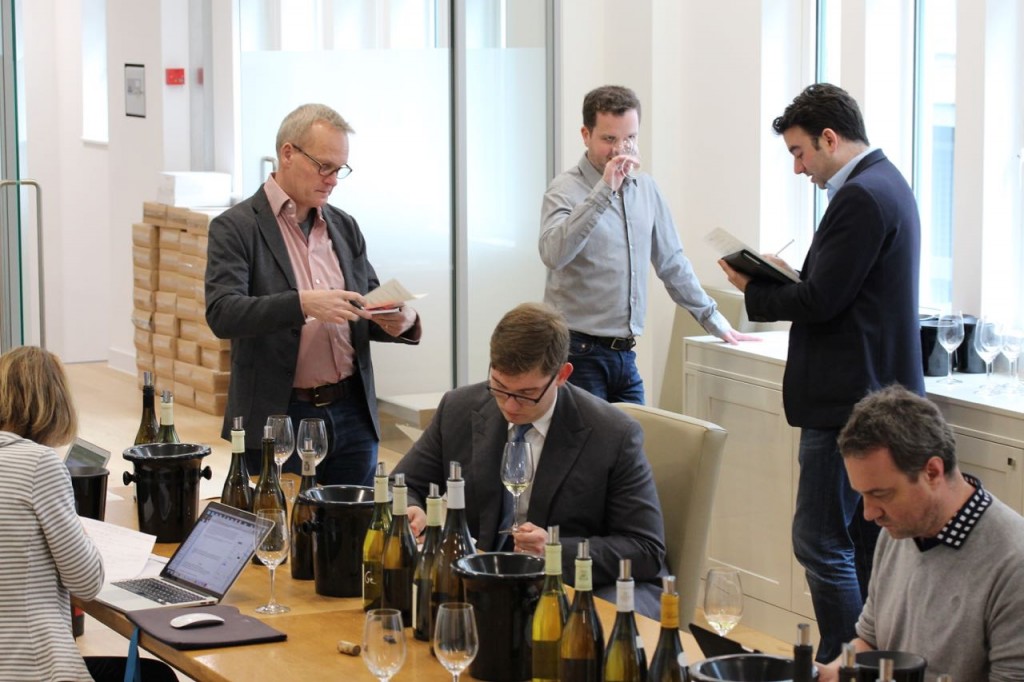
The season & harvest
A vintage which illustrates the old adage ‘the last three weeks make the vintage.’
2008 was another challenging season for growers in the Côte d’Or. It was marked by a poor and rainy summer, punctuated for the unlucky (notably in the lower part of Meursault) by a ferocious hailstorm in late July. The temperatures in July and August struggled to reach a maximum of 25 degrees. The grapes developed slowly in July to August. The rain continued during the first week of August and rain on the 25th caused a second dilution of the grapes. There were outbreaks of downy mildew, oidium and rather a lot of rot.
The final and miraculous second half of September saved the vintage. Many were facing a potential disaster in late August, but the skies cleared and there was light. Growers were able to delay the harvest later than the classic 100 days. “On the 1st day of September there was a lot of rain, but after the 15th September the rain stopped and the mornings were very fresh with lots of wind,” recalls Alain Chavy.
The cold North East wind blew for 10 days was significant in drying the soils, preventing botrytis from spreading and concentrating the sugar and acidity in the grapes. “We were very lucky with the weather,” remarked Olivier Lamy, “The last 3 weeks is more important than August.”
It was not easy to decide when to start picking to achieve a good equilibrium of sugar and acidity. This has resulted in different styles of wine. In Meursault the first harvesters were out on the 22nd and 23rd. Many started from the 28th or so and picked into the first week of October with some finishing in the second week.
At Maison Olivier Leflaive Frank Grux began on the 18th September and finished 15th October and remarks, “It has been a long time since Burgundy has had a harvest in the middle of October. It happened in 1993 and some 1996.”
The grapes yielded very little juice at the press. Many wines had a long slow fermentation. The yeast struggled with low pH and high sugar over the cold winter. Many did more bâtonnage than usual to encourage the sluggish MLF and for added gras to balance the acidity. Rapid late ripening, low yields and the long season led to some over-ripe aromas on some wines.
For growers who had waited, there was no need for chaptalisation. Concentration resulted in high levels of sugar and high levels of acidity. Natural sugars produced wines of 13-13.5 and above 14 for some grand cru. After MLF the Total Acidity was higher than in 2007.
Tasting from barrel in in June 2009 the wines were marked with citrus characters. the style was rich, but straight. I commented at the time, “The small amount of juice was very concentrated. That which is gained in substance may be lost in elegance. However these richer wines have low pHs and, technically, the potential to age. Perhaps this is where the potential of these richer wines may lie, rather than in ripe upfront youth.”
Well I was proved wrong on that last point. When I tasted this vintage in 2012 and 2013 it was gorgeous. The sharp contrast of cold acidity and rich fruit gave it flashy brilliance. I loved them. As if you were looking through polaroid lens, everything was accentuated.
After this they seemed to lose form progressively. Was this just a stage or were they fading out? With some signs of a reprieve, I decided in a rather impromptu fashion to collect wines while tasting the 2015s. I only asked when I had time to explain what I had in mind. It depended on whether the vigneron had a bottle to hand or I could swing back to collect one. Hence Saint Aubin and Puligny are not adequately represented, but 23 wines gives a decent over view.
I was impressed with the overall quality and consistency. The wines ranged from fully mature to still remarkably youthful. As expected the village wines were ready, but some of the premier cru still needed time.
Style of the vintage
I wondered if the style would seem clumsy with time given the reasonably high levels of alcohol and a touch more bâtonnage than usual. On the contrary they were elegantly balanced with bountiful fresh acidity. Some wines had a good deal of substance and matter in palate. For example Lafon, Clos de la Barre was rich, but balanced and Ballot-Millot Meursault Charmes was dense and layered.
Back in 2009 the texture could taste a touch overly thick and viscous. Today this has mellowed to give the wines a delicious textural richness – a smooth deep satin or lighter silk depth to the texture. Jean-Marc Pillot, Chassagne-Montrachet Les Vergers illustrates this silky texture beautifully.
Would the high acidity be too harsh and exposed? It was always a ‘cold’ acidity. Fears were allayed as the wines were fresh and elegant and poised. As young wines the richness of fruit enveloped the acidity and is still the case. The sucrosity of the vintage is still present and delicious.
In many wines below the citrus fruit of the vintage is still evident together with more mature notes of sweet hay and toasted nuts, but the youthful fruity notes in Philippe Colin, Chassagne-Montrachet Chenevottes for example were a surprise.
Selection was paramount in 2008 given the botrytis – a touch of noble rot can evolve quickly into grey rot. I only tasted one wine with noticeable noble rot. I don’t mind this, but not everyone would be happy to taste caramelised orange notes on Burgundy. (Domaine René Lamy Pillot, La Grande Montagne)
Over-ripeness or sur-maturité: A slight note hovered over quite a number of wines I tasted in 2009. Generally however this was a intriguing and complex note of spice – a somewhat pink/purple aroma – giving spicy exotic character on the palate, rather than tropical fruit. Many of the wines showing this were not heavy or fat. It seemed to be an early note of sur-maturité which was quite pleasant. Now in 2017 there are still echoes of this on some of the wine we tasted, which does not detract from the wine and can make them more interesting.
The 2004 and 2007 were so energetic, how would the energy levels of 2008 compare? (Excluding the oxidised wine). Some of the wines had a good deal of punchy vigour, surprisingly so. Only two or three notably lacked energy for mature wine.
Some vintages, 2007 for example, show their terroir from infancy. In other years vintage character dominates. 2008 was vintage dominant. Four years later the same could be said, however the wines now clearly reveal their terroir.
Some rather more mature wines:
Humbert Lamy’s Saint Aubin, En Remilly was somewhat more evolved than I expected. It was elegant, but had moved into more tertiary characters. 2008 was less challenging in Saint Aubin than in the principal villages of the Côte d’Or. There was not that final rush to ripeness. (However I subsequently tasted two more bottles of this wine in Olivier Lamy’s cellar in June and they were considerably fresher.) Domaine Bouzereau, Meursault, Les Genevrières was a delight when I opened it with a light, floral/spicy aroma, but it faded too quickly. It bouquet showed very limited resistance to oxygen, although the delicate palate was lovely.
Quick note: Over the past nine years domaines have pulled back on new oak. There were oaky notes on some of the wines tasted.
Considering the villages individually.
Meursault
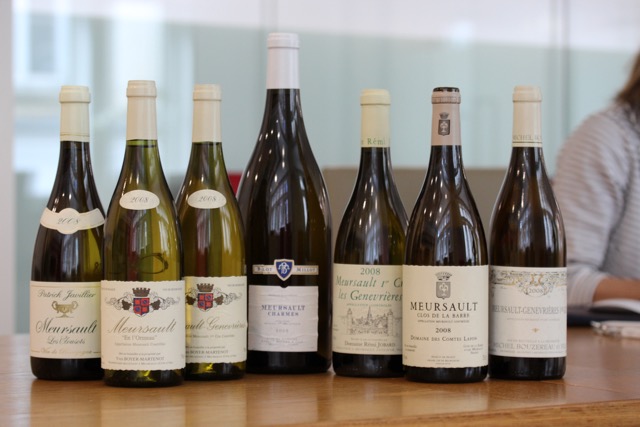
Domaine Jean-Philippe Fichet Meursault, Les Tessons combines the rich gloss of the vintage with straight elegant freshness. This Tessons is textbook. Javillier’s Clousots always has a mineral backbone and in 2008 this supported the freshness on this rather ripe wine. In 2009 I wrote, “Perhaps the best were those that showed some minerality, accentuated by the acidity which acted as a foil to the rich fruit.” I think this holds true. The vintage conditions were exacerbated by the hail in some lower section of the village which resulted in very low yields. There is no hurry to drink the best village wines, but they are lovely now.
My standout wine in Meursault is Domaine Ballot-Millot, Meursault Charmes, an impressive wine with richness and depth balanced with firm acidity and minerality. This is from the upper part of of this climat on rocky soil next to Perrières. This is still very youthful wine. Although we did not taste any Meursault, Perrières, on the basis of tastings from barrel back in 2009 and this Charmes, it is reasonable to assume that the best examples Meursault Charmes and Perrières may just be starting to drink now with a good future over 5 years or so.
Genevrières (in barrel as a group) were fragrant, exotically so. Some with florid richness. Tasting now that exotic perfume is still there. I found Genevrières somewhat uneven in style then and now. I would drink these now.
Puligny-Montrachet
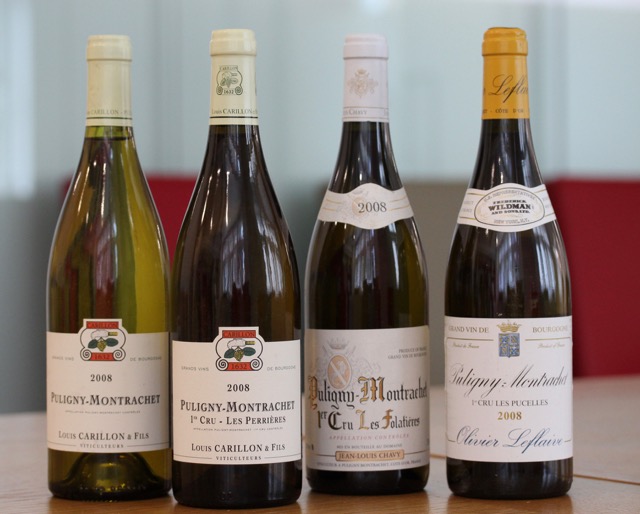
With just four wines you cannot draw any conclusions. The later picking has smoothed the tight line. Domaine Louis Carillon (now this domaine is divided between Francois and Jacques) Puligny-Montrachet and 1er cru Les Perrières stood out for lovely typicité and line.
Chassagne-Montrachet
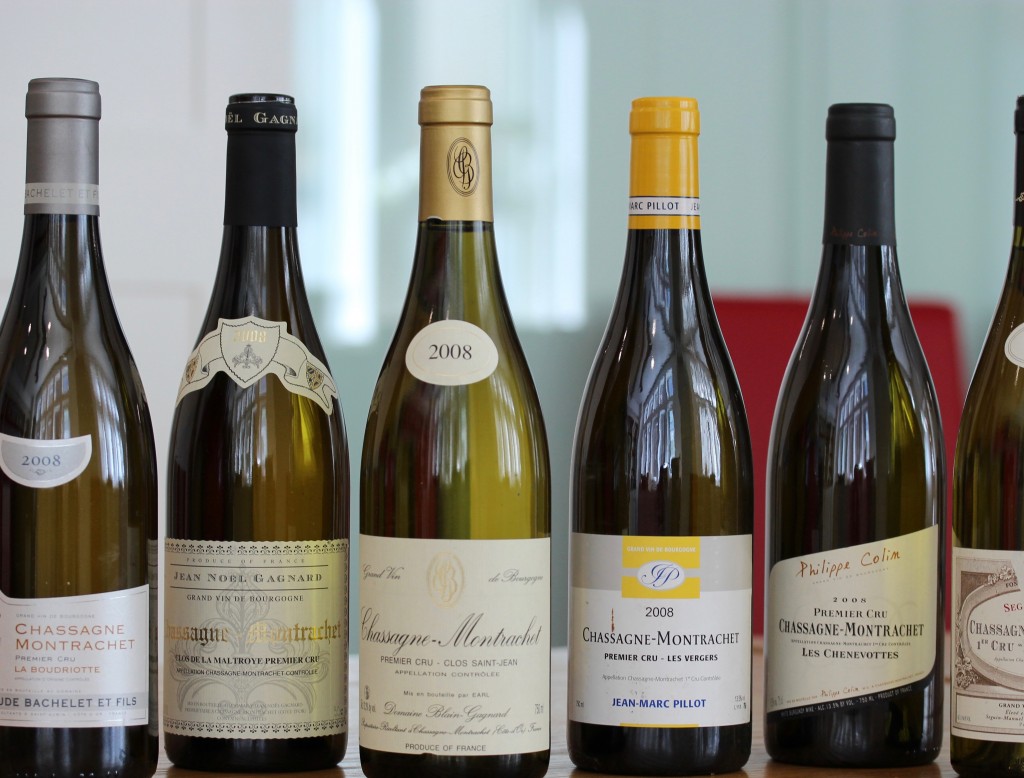
Collectively the wines from Chassagne-Montrachet were the big surprise for me. Among the three villages it shone. The quality was high and consistent and the fruity, fresh, energetic style was most engaging. While still in barrel Chassagne-Montrachet had the richest wines with the thickest texture. They were the most overt. Selecting a harvest date to catch the moment was tricky. Many had concentration of fruit and acidity and were bullishly fruity. This is still the case, but the surprise is how juicily fresh, energetic and youthful they remain as a group.
Many of my favourite wines of this tasting were among this group. Who could ask more from Chenevottes than the gregarious wine from Philippe Colin. Two elegant, silky Vergers; Depth and succulence from Bachelet’s Boudriotte and a focused Morgeots from Domaine Bernard Moreau. At the top end Domaine Jean-Noel Gagnard, Caillerets was rich, straight and powerful. This was a highlight of the tasting and the most impressive wine in the line up.
Chassagne-Montrachet is maturing evolving well. Based on this tasting I would suggest that the fruity forward premier cru on the north side of the village are lovely now. The global Morgeot climat is still on an ascendancy – now and onwards and Caillerets could be opened over 2 to 6 years.
Why has this vintage aged well? The most likely explanation is the concentration. Richer vintages can have greater ageing capacity than the slimmer, lighter and hence more immediately elegant and balanced vintages. We tend to look to good acidity (and low pH) as important for ageing, but it is insufficient alone. It will be interesting to consider the 2009 vintage next year. Does a rich vintage with just sufficient acidity, age more elegantly than a more acid vintage with just sufficient concentration? It should be the case.
The tasting would appear to show that by 2008 the Burgundians were successfully managing the challenges of pre-mature oxidation. Given the wine has minimal movement, I think you can approach 2008 white Burgundy with confidence of a fresh bottle that might well exceed your expectations.
2008 White Burgundy
Tasting notes May 2017
Hautes Côtes de Beaune
Caroline Lestime, Hautes Côtes de Beaune, Sous Eguisons
Appealing fresh lemony aroma. Both lively and generous onto the palate. Really quite floral. Juicy. Some savoury minerality at the end. What a charmer. This has no business to be as good as it is. Interesting this is under screw cap. Super Bourgogne.
Saint-Aubin
Domaine Hubert Lamy, Saint-Aubin, En Remilly
Watch Oliver’s film on this website for his explanation on the soil strata. Under the 40cm top soil there is hard limestone. The roots cannot delve into this limestone in the same was as they grow into the younger more fragmented limestone of Chez Edouard. Hence the latter gives more salty minerality and the hard limestone of En Remilly sweeter minerality.
Mature aroma – more than expected. Kerosene and nutty notes. Falling a little quiet in the middle, but comes back with long, light saline finish. Quite delicate now…floral too at the end. It was livelier then this when I tasted a couple of years ago. Drink now. Score 16.5.
(Saint-Aubin, En Remilly 2008 tasted in Olivier cellar in June. This is juicy. It is lively. This has a lime-like freshness. Lovely minerality at the end. We tried two bottles. The wine stored in Olivier’s cold cellar was maybe a touch fresher and very juicy. While the wine in the cellar above which gets warmer in the summer is more evolved, but the finish is really good too…very long a salty at the end. Very mineral finish. Both were much fresher than the wine we tried in London for the 2008 Time to Mature tasting. That’s bottle variation for you!)
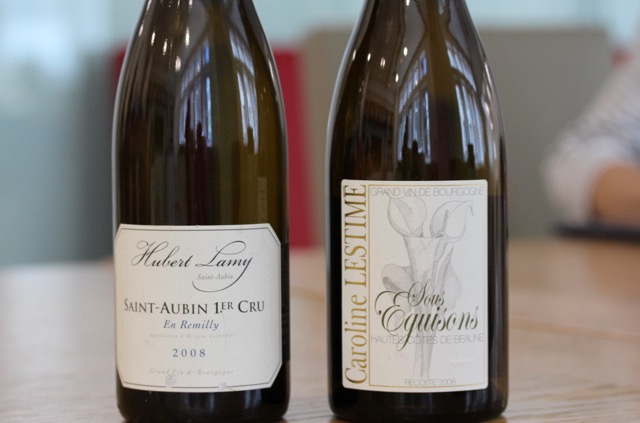
Meursault
Domaine Boyer-Martenot, Meursault, En L’Ormeau
This parcel is at the bottom of the village behind the house. Ninety year old vines in rather deep soil.
Nice and bright on the nose with a hint of lightly toasted hazelnuts. Rounded and rich on the palate. Some weight and concentration for a village wine. Shows the richness of the deeper soils. Marmite. Punchy energy on the finish. Concentrated acidity and flesh. Well balanced village wine. This exceeds expectations for this low lying parcel. Drink now/over the next year or two. Score 15.95
Domaine Patrick Javillier, Meursault, Les Clousots
This is a blend of les Clous and Crotots. Crotots lies below Porusots on clay/limestone soil. Maybe surprisingly Patrick finds more minerality here.
Attractive richness and focus. There is plenty of sweet acidity which cuts through the fruit. Certainly a sense of ripeness. I wondered if it would be too much, but no just a touch of tropical fruit and spice at the end. It’s lovely now. I can see it plateauing over 2 or 3 years. Score 16.5.
*Domaine Jean-Philippe Fichet, Meursault, Les Tessons
Quite closed on the nose, but on the palate is smooth and rounded. It is discrete at first but then opens to reveal and more glossy, juicy character. Excellent balance and intensity. Delicious notes of sweet hay. A subtle wine which grows on the palate and what an attractive silky texture. Long pure and citrus on the finish. Moving towards premier cru level. An elegant wine indeed and among my favourites in the tasting. I like now with fruit and some maturity, but it is still quite youthful and will evolve. Score 17.25
*Domaine Comte de Lafon, Meursault, Clos de la Barre
It faces due east on a very slight slope with shallow, clay soil on a subsoil of hard limestone. The upper reaches of the parcel were replanted in April 2004 (half an hectare).
Notably rich and intense on the nose with a hint of butter mints. Firm, sweet and juicy strike. Impressive intensity for a village wine on the palate. Vigorous and compact. Plenty of energy on the finish. It has weight and firm acidity. A well structured wine, youthful and richly textured wine. No hurry to drink this. It should continue happily for at least five years. Score 17.75
Domaine Michel Bouzereau, Meursault, Les Genevrières
Lightly spicy and exotic on nose when I opened the bottle, but the aroma was not resilient and faded quickly. Delicate, open and light texture. An airy palate. The bouquet faded, but the open lacy palate was attractive and refined to a wafting finish. A light line at the end..both floral and lightly spicy. This was more resilient than the aroma, but had faded when I went back to check. I think those that tasted it first liked it, but those who tasted it later when it had been open for 45 minutes or more, were less impressed. Drink now. Scored 18 when I tasted it first.
Domaine Boyer-Martenot, Meursault, Les Genevrières
This was corked. I will try another bottle and add the tasting note.
Domaine Remi Jobard, Meursault, Les Genevrières
This is rich and full. There is good density. It is full-bodied, yet it has slimed down from the big wine I remember. Plenty of acidity provides balance. Quite compact and concentrated with an underscoring of dark minerality on the finish. Maybe a touch drier at the the end with some oak showing. I went back to taste and found that it had become sweeter and juicier in the mid palate with some air. Wait a couple of years or this might be best decanted. Score 18.20
Domaine Ballot Millot, Meursault, Les Charmes (magnum)
The parcel is at the top of Charmes next to Perrières and and the Puligny side…where you would expect an elegant Charmes.
As a magnum you would expect it to be less evolved than the bottles. Rather oaky. Packs a punch on the palate – truly attacks. Juicy, impressive and concentrated. Rich fruit, cut with firm acidity and minerality. Powerful. It drives home on the finish too. It’s a not full-bodied style – it is straight and broad and with time should hone and refine to become more elegant. This magnum is still in its infancy. Even if you have this in bottle format I would wait a year or two. It should evolve over 5 years. Impressive. Score 18.6
Puligny-Montrachet
Domaine Louis Carillon, Puligny-Montrachet
Slightly lime-like citrus aroma. It is fresh, pure and zesty. Delightfully elegant, but with good intensity. Lively long line to a saline finish. Singing Puligny village wine. You could not wish for more. I would drink it now, but no sign of fading. Score 17.
*Domaine Louis Carillon, Puligny-Montrachet, Les Perrières
Rich, but strictly straight. Very well defined edges. I like the viscosity. Lovely density and acidity in the core. A vigorous, straight Puligny which shows the concentration of the vintage in the concentration of fruit and acidity. Firm, long and focused finish. I’d wait for this wine. I think it will open out more and needs time. Score 18.55
Domaine Jean-Louis Chavy, Puligny-Montrachet, Les Folatières
Jean-Louis has one parcel on stony ground, higher up near Blagny and one parcel which is lower – just above Clavoillon. Bottled November after racking in the summer.
This is quite spicy. Tropical notes and exotic flowers. The palate is really quite juicy. Lively and fresh and elegant at the end. While it does not have the power and intensity of the Perrières, it does have fruity elegance and it’s fresh and engaging. Score 18.2 Now onwards.
Domaine Oliver Leflaive, Puligny-Montrachet, Les Pucelles
Exotically floral and spicy. It has a juicy strike which moves fluidly into the palate where there is plenty of layered density. Quite rich. Clementine notes, indicating ripeness, maybe a touch over -ripe, but cut with firm acidity. Creamy richness envelops the strict acidity. Rather a powerful wine. It’s overt, but also awkward and unresolved. Give it another 2 or 3 years to mature. Score 18.35
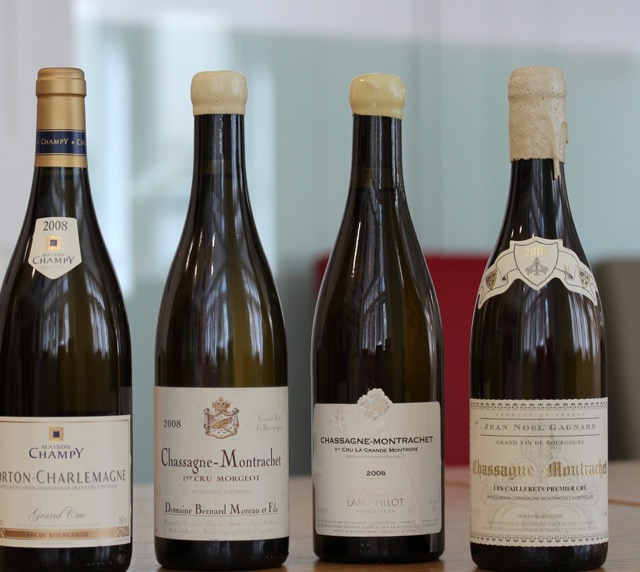
Chassagne-Montrachet
*Domaine Philippe Colin, Chassagne-Montrachet, Les Chenevottes
This has a very fruity aroma. Orange notes. Touch of botrytis maybe. Juicy, ripe and fresh on the attack. Plenty of energy and fruit up front. Mid weight, slightly curvaceous. I do like the gregarious character. Relatively straightforward, but so juicy and fresh. A wine you just want to tuck into now, but no signs it will fade. Score 18.15
Domaine Seguin Manuel, Chassagne-Montrachet, Les Vergers
Inviting concentration of sweet lemon fruit on the nose. This is silky, harmonious and very fresh. Lovely balance. Elegant. Plenty of sweet fruit with maybe a touch of oak showing on the finish. This is still on an upward curve. Now and for 3+ years. Score 18.3
*Domaine Jean-Marc Pillot, Chassagne-Montrachet, Les Vergers
This is a little more reserved than the previous Les Vergers on the nose, while on the palate it is marked by rich, textural sucrosity. It flows in a ribbon of sweet fruit and acidity – elegantly entwined. An excellent harmony of mandarin fruit and sweet acidity which carry to a fresh and spicy finish. Now and for 3+ years. Score 18.5
Domaine Blain-Gagnard, Chassagne-Montrachet, Clos Saint-Jean
On the palate there is ripe orangey fruit. Quite juicy up front and opens into a broad and rounded palate. It’s fruity, but to be very critical is a bit heavy, lacking in energy and a touch shorter than expected. Score 17.5
Domaine Jean-Noel Gagnard, Chassagne-Montrachet, Clos La Maltroye
Slightly odd aroma. I was going to go back and check, but forgot and then the wines were gone. Maybe the oak. The attack is assertive. This is juicy and robust. Loads of ripe fruit and good acidity to balance. Fruit driven wine with an ‘earthy’ mineral finish. It’s not subtle. Score 18
*Domaine Jean-Claude Bachelet, Chassagne-Montrachet, La Boudriotte
A ripe, concentrated, slightly oaky aroma. This is powerful and gutsy on the front palate. Rounded and full middle. It is rich, but with plenty of concentrated acidity too. It has a really firm core. The balance is good. Quite a muscular wine. Powerful onto the finish. For all this it not a showy wine..it’s compact and concentrated and strong. This is a wine which is on an upwards slope. Hint of oak present still. Wait a year or two and drink over five years. Score 18.65
*Domaine Bernard Moreau et Fils, Chassagne-Montrachet, Morgeot
No so much oak showing here. Pure, elegant and streamlined on the palate…and this is Morgeot. Straight and focused. Keen chiselled edges. Really very good channelling of fruit acidity and energy. This is a wine on the ascendancy. Still youthful. Stylish wine. Score 18.65
Domaine Lamy-Pillot, Chassagne-Montrachet, Grand-Montagne
Ripe citrus fruit on the strike. This looked promising. Some botrytis notes of caramelised orange. Straight wine. It has savoury acidity. Somewhat exotic, but this fruitiness fades quickly and it will not develop further. There is a decent balance of acidity and fruit, but it is slightly dry on the finish. Some white 2008 went through this stage when the palate wines seemed a bit flat and dry and they came back, but I am not sure this will. I think it’s fully mature. Score 17.5
*Domaine Jean-Noel Gagnard, Chassagne, Caillerets
Cool and reserved. Some oak showing. There is sweetness and succulence here. Juicy and generous on the front palate. Powerful and concentrated. Straight mineral core. Excellent depth. This is a perfect example of the vintage character where the fruit wraps around the acidity and the minerality and acidity provide structure. A persistent and assured finish. Score 18.75
Corton-Charlemagne
Maison Champy, Corton-Charlemagne Laleure-Piot
Unfortunately this was oxidised.
Comments from some other tasters in alphabetical order Tim Atkin, Giles Burke-Gaffney, William Kelly, Nigel Platts-Martin and Steven Spurrier. (Below Tim with Catherine Petrie, Buying and Marketing Manager for Goedhuis).
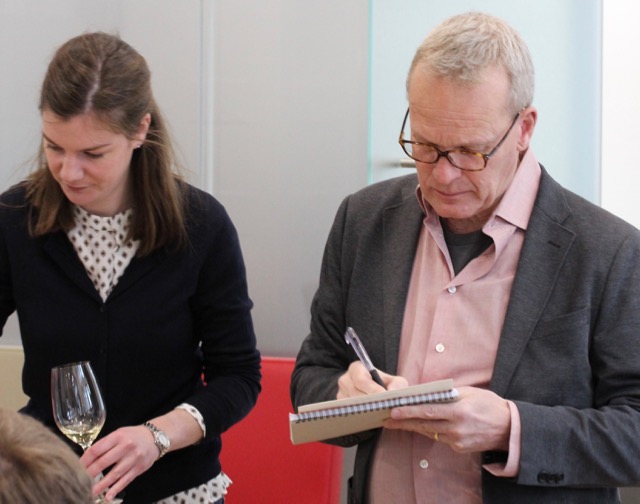
Tim Atkins MW
“In many ways, you could argue that this was the first properly post-premox vintage. This doesn’t mean that premature oxidation is completely a thing of the past, but vignerons seem to be much better at preventing (or avoiding) it than they were. That was borne out by this tasting, where only one of the wines was very tired and one past its best. The acidity of the vintage clearly helped, but there are signs that the problem has been understood, which is a relief for collectors of white Burgundy, which includes journalists!
2008 has never been my favourite Burgundy vintage, as you know, but I think it’s generally much better for whites than reds, as higher acidity vintages tend to be, at least in the shorter term. I thought that the range of wines showed really well overall. Most were good to drink now but will age further in bottle for 2-8 years at least. I was impressed by the purity of the fruit flavours and the palate length.”
Top scores were:
Jean-Claude Bachelet, La Boudriotte 97
Clos de la Barre 96+
Carillon Les Perrières 96+
Jean-Noël Gagnard, Les Cailerets 96
Philippe Colin Les Chenevottes 95
Giles Burke Gaffney (Justerini & Brooks)
“Overall this was an unexpectedly uplifting tasting. Encouraging that out of 23 wines tasted only one was over the hill. Of course with any tasting of breadth like this there were some hits and misses. But the hits offered all that you could wish for from white burgundy: body without heaviness, character and complexity, intensity liveliness and a sense of place. The best 08s have aged well, they weren’t just holding on, they needed time, the more you went back the more you got from them. Particular favourites were Jean-Philippe Fichet’s Tesson, Lafon Clos de la Barre, Carillon Perrières, Philippe Colin Chenevottes and Jean-Noel Gagnard Caillerets.”
William Kelly (writing for Decanter)
“I was impressed by how well the wines were developing, with only two showing signs of premature oxidation: the Lamy with its touch of acetaldehyde on the nose and the Champy Corton Charlemagne which was further down the hill. The wines were less marked by botrytis than I expected—I didn’t encounter much in the way of musky fruit tones—and they wore the pronounced acids of the vintage well. I really enjoyed Fichet’s Tesson, Lafon’s CdlB and Alex Moreau’s Morgeot (though I think the latter’s wines today show better integration of barrel toast), but my favourite wine of the tasting was the Louis Carillon Perrieres.”
Catherine Petrie (Goedhuis & Co.)
“Particular highlights for me were – Lamy St Aubin En Remilly; Javillier Meursault Les Clousots;
Comtes Lafon Meursault Clos de la barre (brilliant with the cheese at the end!);Ballot Millot Meursault Les Charmes (my winner); Carillon Puligny les Perrieres; Moreau Chassagne Morgeot;
Gagnard Chassagne Caillerets
Nigel Platts-Martin (Restauranteur)
“I expected white burgundies of this age to be a mixed bag notwithstanding the pedigree of the growers. But I was pleasantly surprised that there were relatively few premoxed wines on show.
“Standout wines for me (with my perfunctory notes) were:
Hautes Cotes de Beaune Caroline Lestime – this was a revelation. Remarkable for its level and bright as a button. Still youthful.
Chassagne Caillerets Jean Noel Gagnard – a class act as usual. Streets ahead of the Clos La Maltroye (as was the above).
Chassagne Vergers Jean Marc Pillot – powerful, but vivacious and very well made. Most impressive and just hitting its stride.
Chassagne Boudriotte Jean Claude Bachelet – not a grower I am familiar with but this impressed. Big and powerful for sure but with plenty of poise to provide satisfaction.
Puligny Carillon – spicy and concentrated with excellent shape. Ace village Puligny. Outperformed the Perrieres on the day.
Meursault Les Clousots Javillier – much more like it after the somewhat ponderous Boyer-Martenot. This was delightful and brimming with energy. A lovely precise village Meursault from an unfamiliar lieu dit.
Meursault Tessons Fichet – classic Meursault. Richly nutty, convincing flavours combined with perfect poise and shape. An over performing lieu dit. Lovely.
Meursault Genevrières Remi Jobard – spicy, stylish, very attractive and very very long. Yum.
Honourable mentions also to the Ballot Millot Charmes, Chavy Folatieres, Philippe Colin Chenevottes and a surprisingly good Seguin Manuel Chassagne Vergers.
I wonder how much consensus there will be amongst all those experienced tasters in the room all busy making copious notes…..certainly over lunch there was disagreement at my end the table over the merits of the Lafon Meursault Clos de la Barre.”
Xavier Rousset Master Sommelier (La Cabotte, London)
Xavier was disappointed with Puligny, with the exception of Carillons village wine, but felt the Chassagne exceeded expectations. He was surprised to find so little oxidation, but many of the 2008 wines he has tasted have moved from France to the States and back to the UK and it may be that in this movement the wines have suffered. He has experienced more problems with the 2008 than this tasting would indicate.
Steven Spurrier (writing for SOMM Magazine in the US)
“With only one exception, the Champy Corton-Charlemagne, the wines were in good shape and more than most had a few years in front of them. Not knowing the conditions of the vintage, I would put this down to good natural acidity and not too much oak.”
“As for the wines, they were very recognisable in their appellations. The Meursaults from Patrick Javillier, Jean-Philippe Fichet and Domaine Lafon were excellent and almost 1er Cru quality, while the quality of Boyer-Martenot’s Genevrieres put it top for me in this group. The Pulignys were all very good, moving up in quality from the much better than expected Villages, through Les Perrieres and Les Folatieres to reach a peak with Olivier Leflaive’s Pucelles.”
“I have to admit that Chassagne-Montrachet is my favourite of the three appellations, and I had not a single note under 17.25/91 with the Jean-Noel Gagnard Caillerets coming last and best.”
Charles Taylor MW
“My favourites for what it is worth were the Lafon Clos de la Barre, the Fichet Tessons and Ballot-Millot Charmes the two Carillons, Jean-Marc Pillot’s Vergers, the Bernard Moreau Morgeot and the Gagnard Caillerets. Overall I thought the vintage was showing well with interesting balance of ripe honeyed fruit and crisp acidity. A rare combination.”


